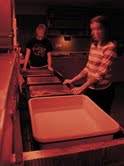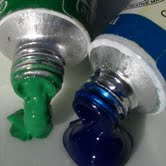Contribute
| South Asian Art - Art And The Environment |
Razvin Namdarian
01/19/2010
Art and the Environment There will always be appreciation of good art - there will always be art critics who will discuss the composition, colour choice, brush work ... executed by an artist, but has anyone ever stopped to consider at what cost to the environment was the artwork created? These days when one speaks of environmental costs and tradeoffs, who is to measure the ‘carbon footprint’ of an artistic creation? There are many mediums and techniques of creating art but one wonders if the artist or the collector ever considered the environmental impact of the process and materials used in creation? Looking on the bright side, let’s start with which art is definitely 100% environment friendly. In the Indian context one has to admit that tribal and traditional art are top contenders for the “Most Eco-friendly†award! These artworks are created by artists who have learnt over generations to live in harmony with nature and their art and the process of its creation reflects this understanding of sustainable living. Most tribal artists use handmade cloth on which to paint which is itself made by using environment friendly techniques on hand powered looms. In the Warli tribal artform, the background colours are derived from red earth called ‘gerue’ or cow dung paste and they use rice paste as the white colour to create the artworks. Similarly in the case of traditional Indian art like Madhubani, Gond or Patachitra the artists use natural or vegetable dyes – the yellow is turmeric, the black is from the soot of lamps, the green is from crushed leaves...Even the instruments for paint application are natural elements like tree twigs or grass brushes. So if any leftover paint is washed away at the pond or river side, it is nothing more than, to paraphrase the bible, “dust to dust.†When there is any form of industrial processing involved, there are bound to be some synthetic and chemical elements. Paints consist of three main components: Pigment gives it color; the binder or resin makes the pigment stick when the paint is applied and forms a solid layer of paint; and the carrier or solvent keeps the paint in liquid form and evaporates once the paint is exposed to air. Other additives are sometimes used to thicken paint, plasticizers, antioxidants, fillers, wetting agents, retarders... the environmental and health impact of which have not been well researched. Preservatives used in paints are especially hazardous; those commonly used are paraformaldehyde or formalin, phenol, mercury compounds, bleach, and a host of commercial fungicides and pesticides. Thus, while traditionally made watercolours would be considered environment friendly, the modern manufactured ones are not necessarily so. Traditionally, painters would manufacture their own water colours using natural ingredients like organic pigments, gum arabic, honey or corn syrup, white wheat starch, glycerine and water. Now, commercial considerations require that some natural ingredients like gum arabic (whose supply is erratic) are replaced with synthetic alternatives, also, to increase the shelf life of the paints fungicides and preservatives are added. Certain pigments like cadmiums are synthetically created. Also, the paints are packaged in plastic containers which are not environment friendly when disposed. Water based paints such as acrylic paints also contain chemicals such as glycol ethers and alcohols as the carrier. Oil paints contain volatile organic compounds (VOCs) as the carrier as well as chemical dryers which may contain lead or manganese. None of which are environment friendly. The process of print making, that is intaglio, would be considered high on the scale of environmentally detrimental art. The zinc plates used, the chemicals and acids used for etching, the inks used for dying...all contribute to harming the environment. The top position of environment unfriendly art needs go to the art of photography. The development of photographic film requires the intensive use of chemicals which have a high biological oxygen demand. A bleaching agent commonly used in darkrooms is potassium ferricyanide which when poured down the drain decomposes to release cyanide gas! The best way to ensure that art is as appealing to the environment as it is to aesthetics is for the artist to opt for environment friendly art supplies whenever possible. It is possible For instance sustainability in art can be ensured by using recycled, handmade paper; using organic paints, digital photography, reusable plates and careful disposal of chemicals when making prints etc. Everyone needs to do their own bit for the environment and when art does so much for the emotional realm; should not the art community too do its bit for the physical realm? ~ Razvin Namdarian
You may also access this article through our web-site http://www.lokvani.com/




